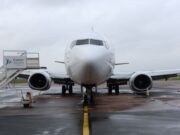
Let’s face it: Go-arounds are inconvenient. They make you late, burn more gas, complicate air traffic situations and often scare the heck out of your passengers, who probably think you did something wrong. Inconvenient, yes, but essential to safe flying.
The Foundation’s Approach and Landing Accident Reduction Tool Kit was developed to reduce the risk of this most common form of accident, and one of the key elements of the advice it contains is the warning against unstabilized approaches. Early in the approach, the focus should be on maintaining or regaining a stabilized approach. At the end, however, there is but one remedy if the approach is still unstabilized: go around.
Most pilots are aware of this advice and do not dispute its general validity. However, recent studies from Airbus and the U.S. Federal Aviation Administration have shown that although unstabilized approaches are rare — only 3–4 percent of all approaches — only 2–3 percent of the unstablized approaches end in a go-around. Right now, the Foundation is participating in an industry effort to understand the problem more fully, but earlier this year, Rudy Quevedo, FSF deputy director of technical programs, launched a social network discussion on LinkedIn.
“Annually approximately 30 percent of the industry accidents are runway excursions,” Quevedo said. “Many of these excursions are the result of unstable approaches. Statistically, approximately 97 percent of unstable approaches continue to landing, despite policies and procedures that dictate otherwise. The runway excursion accident rate can be dramatically reduced by a higher compliance rate of go-around policies, specifically — the decision to go around when appropriate.” He asked, essentially, why go-arounds are so rare and how that can be changed.
The discussion on this topic has been very good. These points have been raised:
- Whenever pilots fight through an unstabilized approach to a safe landing, unsafe behavior is reinforced.
- Pilots are motivated by pride or company pressure to “get the job done.”
- Reduced fuel loads arriving at destinations.
- The fatigue issue, which boosts the “need” to get down while diminishing the pilot tools available to achieve the desired outcome.
- Inadequate training on stabilized approaches and go-arounds, and on crew resource management, to avoid getting into situations where a go-around is necessary.
- Inadequate management response to evidence of high rates of unstabilized approaches and low rates of go-arounds.
- Inadequate management knowledge about the state of operations, i.e., no or poor monitoring programs in place.
- Both pilot flying and pilot monitoring must be empowered to call for a go-around. It should go without saying that airline policies do not penalize pilots who do go around.
Many real-world situations dirty the water when discussing clear guidelines for when a go-around is crucial. Even though the decision is cast as a binary yes/no, “we will always have some gray area, and the challenge is to define that area so well that it can be handled in standard operating procedures, training in pilot decision making, approach planning, conducting the approach, etc.,” one commenter said. A good example of this is an approach where all of the elements are nailed except for one, and that one is drifting toward the correct numbers.
You’ll be hearing more about this in the very near future as the industry go-around information effort gets into some meat in its study. It will be worth following closely.



